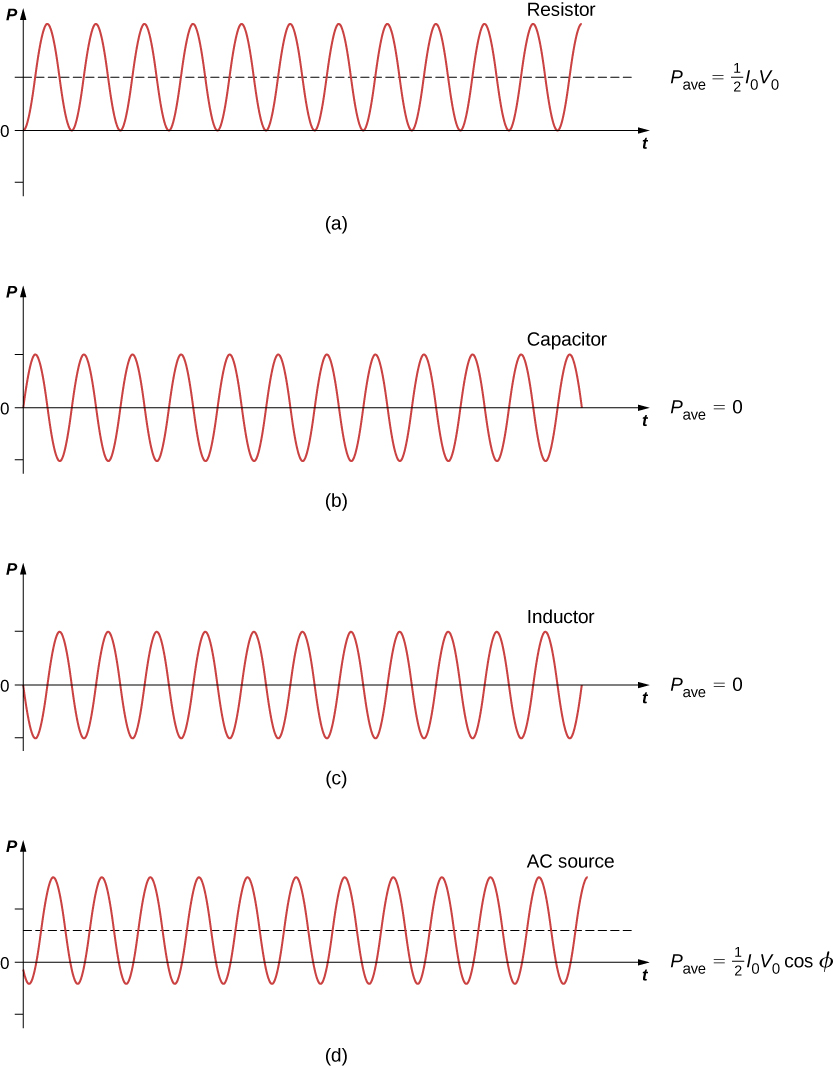15.5: Power in an AC Circuit
( \newcommand{\kernel}{\mathrm{null}\,}\)
By the end of the section, you will be able to:
- Describe how average power from an ac circuit can be written in terms of peak current and voltage and of rms current and voltage
- Determine the relationship between the phase angle of the current and voltage and the average power, known as the power factor
A circuit element dissipates or produces power according to P=IV, where I is the current through the element and V is the voltage across it. Since the current and the voltage both depend on time in an ac circuit, the instantaneous power p(t)=i(t)v(t) is also time dependent. A plot of p(t) for various circuit elements is shown in Figure 15.5.1. For a resistor, i(t) and v(t) are in phase and therefore always have the same sign. For a capacitor or inductor, the relative signs of i(t) and v(t) vary over a cycle due to their phase differences. Consequently, p(t) is positive at some times and negative at others, indicating that capacitive and inductive elements produce power at some instants and absorb it at others.

Because instantaneous power varies in both magnitude and sign over a cycle, it seldom has any practical importance. What we’re almost always concerned with is the power averaged over time, which we refer to as the average power. It is defined by the time average of the instantaneous power over one cycle:
Pave=1T∫T0p(t)dt,
where T=2π/ω is the period of the oscillations. With the substitutions v(t)=V0sinωt and i(t)=I0sin(ωt−ϕ), Equation ??? becomes
Pave=I0V0T∫T0sin(ωt−ϕ)sinωtdt.
Using the trigonometric difference identity
sin(A−B)=sinAcosB−sinBcosA
we obtain
Pave=I0V0cosϕT∫T0sin2ωtdt−I0V0sinϕT∫T0sinωtcosωtdt.
Evaluation of these two integrals yields
1T∫T0sin2ωtdt=12
and
1T∫T0sinωtcosωtdt=0.
Hence, the average power associated with a circuit element is given by
Pave=12I0V0cosϕ.
In engineering applications, cosϕ is known as the power factor, which is the amount by which the power delivered in the circuit is less than the theoretical maximum of the circuit due to voltage and current being out of phase. For a resistor, ϕ=0, so the average power dissipated is
Pave=12I0V0.
A comparison of p(t) and Pave is shown in Figure 15.5.1d. To make Equation ??? look like its dc counterpart, we use the rms values Irms and Vrms of the current and the voltage. By definition, these are
Irms=√i2ave
and
Vrms=√v2ave,
where
t2ave=1T∫T0i2(t)dt
and
v2ave=1T∫T0v2(t)dt.
With i(t)=I0sin(ωt−ϕ) and v(t)=V0sinωt, we obtain
Irms=1√2I0
and
Vrms=1√2V0.
We may then write for the average power dissipated by a resistor,
Pave =12I0V0=IrmsVrms=I2rmsR.
This equation further emphasizes why the rms value is chosen in discussion rather than peak values. Both Equations ??? and ??? are correct for average power, but the rms values in the formula give a cleaner representation, so the extra factor of 1/2 is not necessary.
Alternating voltages and currents are usually described in terms of their rms values. For example, the 110 V from a household outlet is an rms value. The amplitude of this source is 110√2V=156V. Because most ac meters are calibrated in terms of rms values, a typical ac voltmeter placed across a household outlet will read 110 V.
For a capacitor and an inductor, ϕ=π/2 and −π/2rad, respectively. Since cosπ/2=cos(−π/2)=0, we find from Equation ??? that the average power dissipated by either of these elements is Pave=0. Capacitors and inductors absorb energy from the circuit during one half-cycle and then discharge it back to the circuit during the other half-cycle. This behavior is illustrated in the plots of Figures 15.5.1b and 15.5.1c which show p(t) oscillating sinusoidally about zero.
The phase angle for an ac generator may have any value. If cosϕ>0, the generator produces power; if cosϕ<0, it absorbs power. In terms of rms values, the average power of an ac generator is written as
Pave=IrmsVrmscosϕ.
For the generator in an RLC circuit,
tanϕ=XL−XCR
cosϕ=R√R2+(XL−XC)2=RZ.
Hence the average power of the generator is
Pave=IrmsVrmscosϕ=VrmsZVrmsRZ=V2rmsRZ2.
This can also be written as
Pave=I2rmsR,
which designates that the power produced by the generator is dissipated in the resistor. As we can see, Ohm’s law for the rms ac is found by dividing the rms voltage by the impedance.
An ac generator whose emf is given by
v(t)=(4.00V)sin[(1.00×104rad/s)t]
is connected to an RLC circuit for which L=2.00×10−3H,C=4.00×10−6F, and R=5.00Ω.
- What is the rms voltage across the generator?
- What is the impedance of the circuit?
- What is the average power output of the generator?
Strategy
The rms voltage is the amplitude of the voltage times 1/√2. The impedance of the circuit involves the resistance and the reactances of the capacitor and the inductor. The average power is calculated by Equation ??? because we have the impedance of the circuit Z, the rms voltage Vrms, and the resistance R.
Solution
- Since V0=4.00V, the rms voltage across the generator is Vrms=1√2(4.00V)=2.83V.
- The impedance of the circuit is Z=√r2+(xl−xc)2=√(5.00Ω)2+[(1.00×104rad/s)(2.00×10−3H)−1(1.00×104rad/s)(4.00×10−6F)]2=7.07Ω.
- From Equation ???, the average power transferred to the circuit is Pave=V2rmsRZ2=(2.83V)2(5.00Ω)(7.07Ω)2=0.801W.
Significance
If the resistance is much larger than the reactance of the capacitor or inductor, the average power is a dc circuit equation of P=V2/R, where V replaces the rms voltage.
An ac voltmeter attached across the terminals of a 45-Hz ac generator reads 7.07 V. Write an expression for the emf of the generator.
- Answer
-
v(t)=(10.0V)sin90πt
Show that the rms voltages across a resistor, a capacitor, and an inductor in an ac circuit where the rms current is Irms are given by IrmsR,IrmsXC, and IrmsXL, respectively. Determine these values for the components of the RLC circuit of Equation ???.
- Answer
-
2.00 V; 10.01 V; 8.01 V


